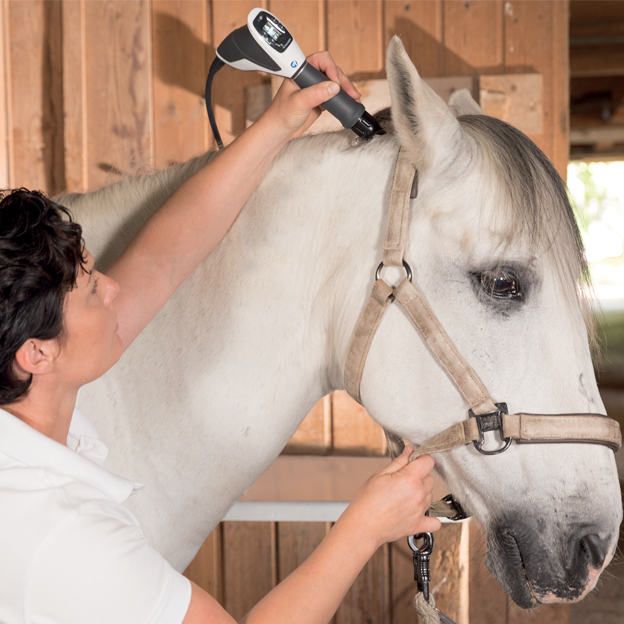Just How Laser Therapy in Equine Treatment Is Transforming Vet Look After Horses
Laser therapy has actually become a transformative technique in equine veterinary treatment, supplying a non-invasive solution that expedites healing and enhances general health. Leveraging precise light wavelengths, this innovative therapy promotes mobile regrowth, minimizes inflammation, and minimizes discomfort. Its efficiency prolongs from bone and joint injuries to chronic ailments like osteoarthritis, dramatically improving flexibility and life top quality for horses. The portability and adaptability of laser therapy devices additionally underscore their growing necessity amongst vets. As we check out the elaborate auto mechanics and real-world successes, the profound influence on equine medical techniques ends up being increasingly apparent.
Comprehending Laser Treatment

The innovation behind laser therapy is based in the concept of photochemistry, where photons are taken in by chromophores within cells, causing raised ATP manufacturing and inflection of reactive oxygen species (Equine Therapy). This, consequently, advertises cellular proliferation, decreases swelling, and increases recovery. Vet experts make use of various types of lasers, including low-level lasers (LLLT) and high-power Class IV lasers, relying on the particular healing objectives and the nature of the equine problem being dealt with
Different laser wavelengths and power settings are thoroughly selected to target different cells depths and achieve wanted professional results. Safety and security procedures are critical, as improper usage can cause thermal damages or suboptimal healing effects. Hence, a detailed understanding of laser treatment's mechanisms and applications is important for its effective execution in equine vet technique.
Benefits for Horse Health
The myriad advantages of laser therapy for equine health and wellness incorporate improved recovery, discomfort reduction, and boosted movement. This sophisticated therapy modality leverages specific wavelengths of light to pass through tissues, boosting mobile function and advertising rapid cells fixing. The non-invasive nature of laser treatment ensures marginal tension and discomfort for the equine, facilitating a smoother healing procedure.
Enhanced healing is one of the foremost benefits, as laser therapy speeds up mobile regeneration and collagen synthesis. Discomfort decrease is achieved through the anti-inflammatory impacts of laser treatment, which reduces swelling and minimizes the manufacturing of pain-inducing chemicals.
Enhanced flexibility is an additional essential advantage, specifically for performance and functioning equines. By reducing inflammation and discomfort, and boosting tissue fixing, laser therapy helps in bring back joint function and muscle flexibility. The collective effect of these benefits is not only a quicker return to typical task however also an overall enhancement in the horse's quality of life. Thus, laser treatment stands as a transformative device in contemporary equine veterinary treatment.
Typical Conditions Treated
Laser treatment has arised as a flexible treatment alternative for a variety of common equine conditions. Additionally, laser treatment is efficient for conditions like osteoarthritis, where it aids alleviate joint inflammation and advertise tissue repair.
Wound monitoring is an additional location where laser therapy has actually shown significant guarantee. Chronic injuries or slow-healing ulcers can be particularly challenging in equines, yet laser therapy enhances cellular regeneration and boosts blood flow, thus accelerating the recovery procedure. Moreover, laser therapies have been effectively used in managing unguis problems such as laminitis and abscesses, easing pain and promoting quicker healing.

Innovation Behind Laser Treatment
Past the myriad conditions treatable with laser therapy, the technology itself values closer assessment. At the heart of laser treatment is using particular wavelengths of light to penetrate tissues and generate biological reactions. These wavelengths, generally varying from 600 to 1000 nanometers, are selectively taken in by chromophores in the skin, muscular tissue, and other cells, prompting a waterfall of cellular occasions.
Laser gadgets used in vet medication commonly use low-level laser therapy (LLLT) or cold laser treatment. Unlike high-powered medical lasers, these tools operate at reduced power levels, maximizing healing benefits while reducing thermal damages. The energy from the laser light promotes adenosine triphosphate (ATP) production, improves mobile metabolic rate, and increases cells repair processes.

Success Stories and Study

Showcasing the substantial advantages of laser therapy, countless success stories and situation studies illuminate its transformative influence on equine wellness. One such situation entails a thoroughbred racehorse struggling with persistent tendonitis. Standard treatments yielded very little improvement, however after integrating laser therapy into the regimen, the equine showed significant reductions in swelling and discomfort within weeks, inevitably returning to competitive auto racing.
Another compelling instance includes a dressage horse identified with severe back pain, limiting its performance. A veterinary group employed low-level laser therapy (LLLT) to target the swollen areas, causing marked enhancement in versatility and a significant reduction in discomfort. Over a number of sessions, the horse reclaimed its peak form, showcasing the efficiency of laser treatment in resolving bone and joint concerns.
Additionally, a research study carried out at a leading equine center checked out 50 equines with various soft cells moved here injuries treated with laser therapy. The outcomes were striking: 85% of the horses showed increased healing times and enhanced mobility. These instances underscore the adaptability and effectiveness of laser treatment in equine medicine, providing a non-invasive, scientifically-backed technique to improving recovery and efficiency in steeds.
Verdict
Laser therapy is transforming equine veterinary treatment by giving a non-invasive therapy that speeds up healing, decreases swelling, and reduces pain. With its efficiency in dealing with an array of conditions, from bone and joint injuries to persistent disorders like osteo arthritis, this technology dramatically enhances equine wellness and flexibility. The portability and versatility of laser treatment better underscore its transformative effect on vet practices, strengthening its duty as click here for more an essential tool in contemporary equine medical care.